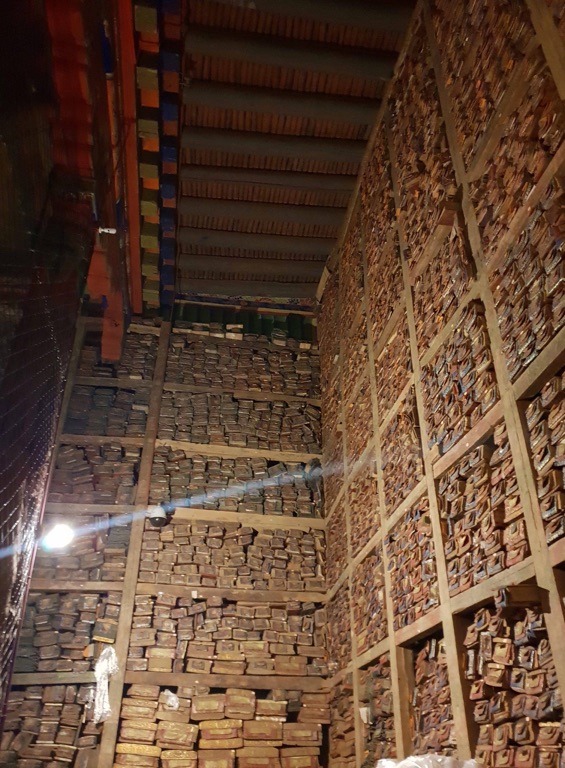Sakya Monastery, a significant historical and religious site, stands as a testament to Tibetan Buddhism’s rich heritage. Nestled in the town of Sakya in the Tibet Autonomous Region, it is the principal monastery of the Sakya sect of Tibetan Buddhism. Founded in 1073 by Khon Konchog Gyalpo, it became a pivotal center for Buddhist learning and culture. The monastery is renowned for its vast collection of scriptures, murals, thangkas, and religious artifacts. It also features a unique architectural style, with its grand hall and fortress-like walls, reflecting the fusion of religious and military functions throughout its history.
Get your dose of History via Email
Historical Background of Sakya Monastery
The Sakya Monastery’s story begins in 1073 when Khon Konchog Gyalpo established it. He belonged to the noble Khon family, which had a long association with Buddhism. The monastery quickly became a hub for religious and secular learning. It played a crucial role in the Mongol conquest of Tibet. The Sakya leaders, known as the Sakya Pandita, were pivotal in establishing a relationship with the Mongol rulers. This led to the patronage and protection of the monastery.
Over the centuries, Sakya Monastery has seen both prosperity and decline. It was once home to over 3,000 monks and a vast library of Buddhist texts. The monastery was not only a religious center but also a political one. The Sakya sect ruled Tibet for a period under the Mongol Empire’s auspices. This period is known as the Sakya hegemony.
The monastery has been through several renovations and expansions. The most notable is the construction of the Great Hall by Phagpa, one of the five founders of the Sakya sect. The monastery has also been the scene of significant historical events, including the signing of treaties and hosting of important political figures.
Despite facing destruction during the Cultural Revolution, Sakya Monastery has been partially restored. Today, it continues to be an important site for pilgrimage and study. The monastery’s history is a reflection of the broader political and religious developments in Tibet over the last millennium.
The discovery of Sakya Monastery by the Western world is attributed to explorers and missionaries who visited Tibet in the late 19th and early 20th centuries. Their accounts and photographs introduced Sakya’s cultural wealth to a global audience. The monastery’s historical significance and unique architecture continue to draw interest from historians and tourists alike.
About Sakya Monastery
Sakya Monastery is a fortress-like complex that stands out for its distinctive architectural style. The main hall, known as the Lhakang Chenmo or the Great Hall, is the centerpiece of the complex. It is renowned for its massive size and the extensive collection of scriptures housed within.
The walls of the monastery are painted in stripes of red, white, and grey, giving it the nickname “the striped monastery.” This color scheme is symbolic and unique to the Sakya sect. The construction materials used for the monastery include wood, stone, and earth, typical of Tibetan architecture.
The monastery’s interior is a treasure trove of art. It contains a vast array of murals, thangkas, and statues. These artworks depict various aspects of Buddhist theology and history. The murals, in particular, are considered masterpieces of Tibetan art.
The library of Sakya Monastery is one of its most valuable assets. It holds a collection of over 40,000 books and manuscripts. These include many rare and ancient texts significant to the study of Tibetan Buddhism and history.
The monastery’s design reflects both its religious and military roles throughout history. The thick walls and watchtowers are reminiscent of a fortress, indicating its strategic importance. The layout of the monastery, with its assembly halls, living quarters, and libraries, is designed to accommodate the monastic community’s needs.
Theories and Interpretations
Sakya Monastery has been the subject of various theories and interpretations. Its role in Tibetan history is well-documented, but some aspects remain shrouded in mystery. The monastery’s unique architectural style, for instance, has led to speculation about the influences and symbolism behind its design.
The monastery’s vast library has been a focal point for interpreting Tibetan Buddhism’s evolution. Scholars have used the texts to trace the development of religious thought and practice in the region. The art and iconography within the monastery also provide insights into Tibetan culture and society.
There are theories about the strategic location of Sakya Monastery. Its position may have been chosen for defensive purposes, given its fortress-like qualities. The monastery’s relationship with the Mongol Empire has also been a topic of interest, with some suggesting that it was a calculated political move by the Sakya leaders.
Dating of the monastery and its artifacts has been carried out using various methods. These include textual analysis, architectural styles, and radiocarbon dating. These studies have helped establish a timeline for the monastery’s construction and its role in Tibetan history.
The interpretation of Sakya Monastery’s history is ongoing. As new discoveries are made and old theories are revisited, our understanding of this important site continues to evolve. The monastery remains a key subject for historians and archaeologists interested in the Tibetan plateau’s past.
At a glance
Country: China (Tibet Autonomous Region)
Civilization: Tibetan
Age: Founded in 1073 AD
Conclusion and Sources
The information in this article has been obtained from the following reputable sources:

